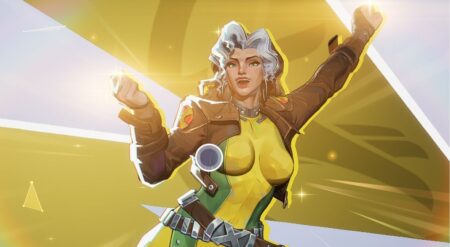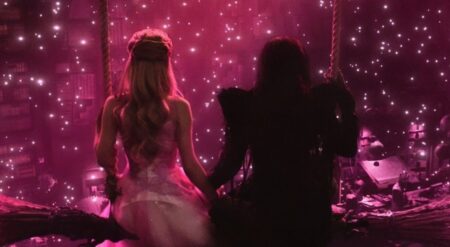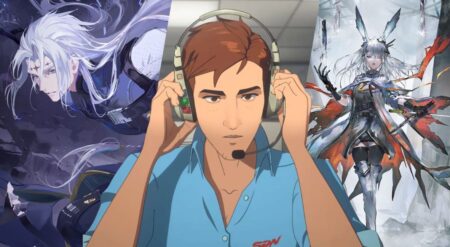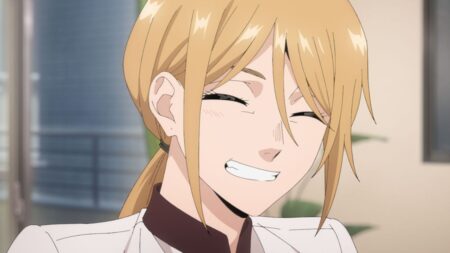Apple TV+ and showrunners Paul and Chris Weitz’s Murderbot continues to crush the sci-fi genre within Apple’s streaming slate—alongside Severance, Silo, For All Mankind, Dark Matter, Monarch: Legacy of Monsters, Invasion and Foundation. Murderbot is a unique futuristic space story that invests its heart and humanity, translating author Martha Wells’ first novella in The Murderbot Diaries series: All Systems Red. Even though the first season is an excellent page-to-screen adaptation, there are a few changes, as outlined below.
1. Overse and Volescu Do Not Appear In Murderbot

One thing All Systems Red’s readers immediately noticed about Murderbot’s TV show adaptation was how Overse and Volescu’s characters were cut out. While the internet was divided about the character subtractions before the show aired, internet denizens quickly understood how Overse and Volescu’s personalities and backstories blended into those of other characters. These characters include Arada (Tattiawna Jones), Gurathin (David Dastmalchian), and Pin-Lee (Sabrina Wu).
Yes, a bigger cast means a bigger show budget. Having a smaller cast allows viewers to connect with the characters more intimately, without being dumped with a bunch of names. Arguably, Overse and Volescu are the perfect candidates to cut out of Murderbot because they didn’t play prominent roles in All Systems Red anyway. Volescu leaves PreservationAux by the end of All Systems Red and never appears in the other books. Overse is Arada’s partner, but doesn’t hugely impact the story until the next novella in The Murderbot Diaries series, Exit Strategy.
Tightening the cast is a major bonus, since I didn’t feel connected to certain characters in All Systems Red because there were numerous characters to keep track of. Apple TV+’s Murderbot combines the character personalities well and captures Preservation’s humanity and weirdness in the best ways possible. Examples include Murderbot commenting on the various Preservation members’ dancing and music selections, on top of the polycule debacle.
2. The First Scenes And Ending Are Changed

Murderbot begins with the titular character narrating in its usual self, but it’s on a random planet getting abused by anonymous humans. Then, the show introduces its main human characters, PreservationAux, who choose the SecUnit to rent from the Company for their survey expedition. None of these opening moments are in All Systems Red.
All Systems Red begins immediately with Murderbot on the planet, observing and talking about how it’s annoyed with the Preservation members. Wells commits to the hard opening in her novella, dropping readers in the middle of the mission where the giant worm alien creature attacks Arada and Volescu. For Murderbot, we see Arada and Bharadwaj (Tamara Podemski) attacked by the worm creature, but the buildup in the show is less out of left field.
I enjoyed Gurathin’s turn from being skeptical of Murderbot to trusting the autonomous SecUnit in the novella, but the show tugs on the heartstrings of their relationship even harder in the show. We learn much more about Gurathin in the show than in the novella, adding details that Gurathin used to be a drug addict before eventually joining Dr. Mensah (Noma Dumezwani) and Preservation. Murderbot’s final scene in Episode 10 with the titular SecUnit and Gurathin had me in bittersweet tears.
For most of the season, Gurathin tries to understand Murderbot on a deeper level. Gurathin admits he’s jealous of the titular SecUnit because Gurathin augments himself to process information faster than the average human, but not as fast as a SecUnit. The ending hits harder because Gurathin is the last person to see Murderbot, after Preservation frees the autonomous SecUnit from its contract with the Company. This also occurs shortly after Gurathin saves Murderbot’s life and memories.
3. Leebeebee Is A Non-Canon Character

Leebeebee (Anna Konkle) is a survivor from the DeltFall survey group, who doesn’t appear in All Systems Red. Despite Leebeebee being a show-exclusive character, she adds a slight change of pace to the show in Episodes 5 and 6. Leebeebee is a perplexing character who initially comes off as playful and chatty, but is cunning and observant in almost successfully infiltrating Murderbot and the Preservation group. Her name alone sounds reassuring, but is ironically a saboteur.
In All Systems Red, the space soap opera-loving SecUnit and PreservationAux learn about GrayCris (at one point in the novella called the EvilSurvey team) and their motives through DeltFall’s security footage. PreservationAux members also further deliberate about the footage in the novella, adding convoluted conversations into the mix. PreservationAux goes in circles talking about what to do about their situation because no one in DeltFall survives, and can confirm what happened in the DeltFall massacre.
Adding Leebeebee to the show is a great narrative device because Murderbot and PreservationAux do not need to deliberate as much when Leebeebee pulls a gun on the group and demands access to the HubSystem. Leebeebee confirms Murderbot’s hypothesis to Dr. Mensah that Leebeebee pretended to be from Preservation to infiltrate DeltFall, and was doing the same thing to Preservation by posing as a DeltFall member. This sounds confusing, but Wells’ novella is about twice as long; Preservation’s debates become repetitive for some time.
4. The Polycule Addition And Murderbot’s Queer Exploration

All Systems Red doesn’t have the polycule that Murderbot Episode 2 presents between Arada, Pin-Lee, and Ratthi (Akshay Khanna). A polycule doesn’t have to be queer, but there’s significant overlap. Murderbot presents exceptional commentary on the difficulties of modern polycules. Where many media depictions provide surface-level explorations of throuples, Murderbot shows the challenges of beginning a polycule—especially when a third-party like Ratthi is forming a contract with a married couple.
While the audience doesn’t see exactly what’s in Arada, Pin-Lee, and Ratthi’s polycule marriage contract, a polycule’s contract is vital for establishing ground rules, boundaries, and expectations from all parties. Murderbot explores the polycule’s terms and boundaries well throughout each episode. A funny example is when Ratthi jokes about having a kid named “Seccy”, in reference to Murderbot. Pin-Lee responds annoyingly because she likely outlined not having children in the contract.
Overall, Murderbot handles its 2 LGBTQIA+ characters and topics in subtle ways that feel very natural in this story world—without having underlying premises that a queer character or topic is forced. Going back to Leebeebee’s comment and attraction to Murderbot, that one-sided attraction shows that the protagonist SecUnit is agender and asexual. Murderbot also mentions how it doesn’t have reproductive parts; otherwise, it would classify itself as “sexbot in a brothel.” Ultimately, the SecUnit uses it/its pronouns as it doesn’t refer to itself in binary gender terms, going as far as to explain to others it doesn’t want to be classified as human either.
5. Less Sci-Fi, Future-Tech Jargon

This is not a major jab at Wells’ All Systems Red, but it had a bunch of technical future space jargon—the lexicon becomes more normalized by the novella’s end. However, Murderbot regulates its sci-fi and future tech words better, using terms like SecUnit, HubSystem, and governor modules when required. Meanwhile, the novella can use in-world terms more frequently. At least the survey team names were still kept in because they sound really cool: PreservationAux, DeltFall group, and GrayCris.
The Apple TV+ show prioritizes character development and emotional resonance over sticking with the source material. Rather than focusing on the sci-fi setting, Murderbot allows audiences to relate more with the titular SecUnit’s desire to be left alone and make awkward attempts at social interactions with PreservationAux. Ultimately, Murderbot doesn’t alienate the general audience from a more regular sci-fi show viewer, and the visual medium eliminates the need to describe the environment.
Bonus: The Rise and Fall of Sanctuary Moon

If none of Murderbot’s humor hits home with audiences, the portrayal of the fictional space soap opera, The Rise and Fall of Sanctuary Moon, will surely make anyone chuckle. One of Murderbot’s most intriguing hobbies is watching human television, mainly the campy varieties. While Wells does a great job explaining how specific scenes from certain episodes help Murderbot understand his fellow survey group members, the visual medium propels this hammed-up sci-fi soap drama—clearly a play on Star Trek.
The cameos also elevate the extreme campiness, including John Cho as a Captain, Clark Gregg as a Lieutenant, DeWanda Wise as a Navigation Unit, and Jack McBrayer as a Navigation Officer. The irony of all the actors is seeing Cho play a space captain since he’s known for playing helmsman Hikaru Sulu in the most recent Star Trek films. While The Rise and Fall of Sanctuary Moon is an in-world show with little substance, it’s one of Murderbot’s distinguishing traits. Murderbot goes so far as to have Alexander Skarsgård sing the sci-fi soap’s intro song to distract the corrupted SecUnit.
Apple TV+’s Murderbot made all the above changes, but never sacrificed the core themes from All Systems Red. The show refines Wells’ writing and amplifies the character development of each character, more so the human characters. None of the show’s changes detrimentally lessened the show; this is why the changes didn’t matter to me. If anything, the changes made this world more charming and heartwarming. The changes also smoothly drop hints for future seasons, if the show continues to adapt the rest of the novella series.
All episodes of Murderbot are currently streaming on Apple TV+.







